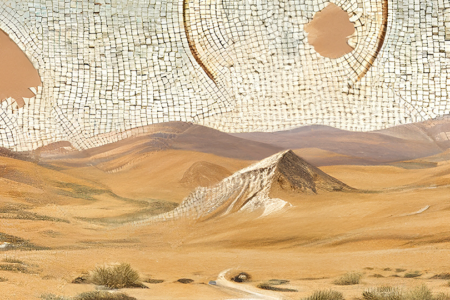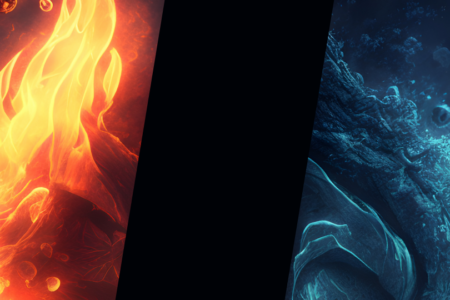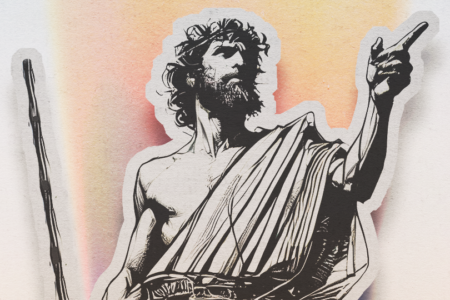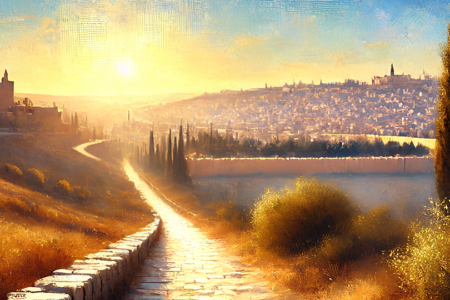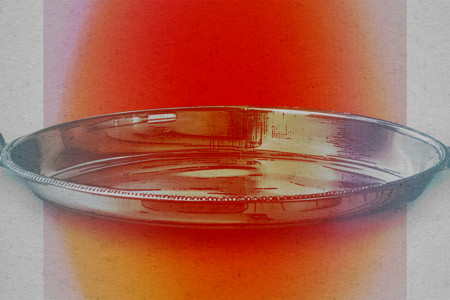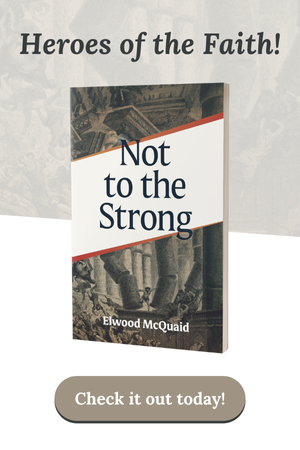THE VEIL: Christ Our Access to God Exodus 26:31-35; 36:35-38
The multicolored veil embroidered with the images of cherubim hung elegantly between the holy place and the holy of holies separating the priest from God’s glorious presence. The images of cherubim gazing upon the movements of the ministering priest left him with the awareness of his holy office.
What must have gone through his mind as he looked at the beautiful veil? Did he think, “What would it be like to enter the veil?” “Would one really die by entering?” “Why not take just a peek into the holy of holies?” “No!” was the convicting voice from his conscience. He vividly remembered how quickly judgment from God fell upon Nadab and Abihu as they had been disobedient in their ministry.
Placement of the Curtains
There were three curtains placed strategically in the tabernacle. Each curtain was made of fine-twined linen into which twisted threads of blue, purple and scarlet were interwoven (Ex. 38:18). Although beautiful to look upon, the veiled entrances associated with the tabernacle were not to be objects of admiration, but performed two basic functions. The word “veil” (Heb. paroketh) means to separate and is descriptive of its ministry. First, the veil acted as a barrier between God and man, shutting God in and man out (Lev. 16:2). Secondly, the curtains were to permit access to worship after the priest had met the required conditions set forth in the Mosaic Law.
First, the “gate of the court” was 7.5 feet high and 30 feet wide, supported by four pillars set in bronze sockets. This curtain separated the people from the tabernacle court. They brought their sacrifice to the gate as an offering to God.
Secondly, the “hanging for the door of the tabernacle” (Ex. 26:36-37) was supported by five pillars of acacia wood overlaid with gold and fastened to the pillars with gold hooks. The five pillars were supported by five bronze sockets. This curtain separated the priest in the tabernacle court from the holy place. Only by virtue of cleansing at the brazen altar and the laver was the priest able to enter the holy place to worship and fellowship with God.
The third veil, and the one we are focusing on, divided the inside of the tabernacle into two rooms: the holy place and the holy of holies. The veil hung from gold hooks supported by four pillars of acacia wood overlaid with gold anchored into four sockets of silver (Ex. 26:31-33).This veil separated the priest from the holy of holies where the presence of God dwelt. Only the high priest could enter once a year on the Day of Atonement to offer blood upon the mercy seat for his and the peoples’ sins.
The veil between the holy place and the holy of holies is described as a “cunning work” (lit. the work of a devisor) [Ex. 26:37]. The workers were given special divine wisdom in the making of this beautiful veil which has never been duplicated.
The awesome figures of the cherubim woven into the veil were images of angelic beings of the highest order. Their character, beauty and power surpass human description. Symbols of cherubim were used by other Semitic people appearing in the likeness of winged lions and bulls to guard their temples and palaces. Ezekiel gives the impression that cherubim have both the characteristics of man and animals (Ezek. 10). The cherubim are symbolic of God’s protective presence over the holy of holies. It was as if God had placed a continuous guard before its entrance saying, “Thus far, but no further!” They were placed at the entrance to the Garden of Eden after Adam and Eve had been driven out to protect the tree of life from being eaten (Gen. 3:24).
The veil that hung in Herod’s Temple during our Lord’s day was quite a thing to behold according to Jewish tradition. There were actually two veils in front of the holy of holies. It was not known, states the Talmud, whether the veil in Sotomon’s Temple hung inside or outside of the entrance to the holy of holies (Yoma 51). According to Maimonides there was no wall between the holy place and the holy of holies, but a space of one cubit (about 18 inches) was assigned to it where the veil was hung. Since the priest in Herod’s time did not know on which side of the cubit the veil was hung, they hung two veils, one nearer the holy place and the other nearer the holy of holies, according to the Talmud the veils were 60 feet long and 30 feet wide, about the thickness of a man’s palm (4 inches), and made of 72 squares which were sewn together. The veils were so heavy that it took 300 priests to hang them according to Jewish tradition.
During the time of Herod’s Temple the high priest entered three times on the Day of Atonement. First, he entered with a censer of hot coals in one hand and incense in the other. Only the light of the hot coals faintly illuminated the empty room of the holy of holies casting a shadowy fed glow throughout the room. The shekinah cloud of God’s glory had filled the holy of holies in Solomon’s Temple, but the glory had departed (Ezek. 10:18; 11:23). The ark of the covenant had also been removed when the Temple was destroyed by the Babylonians. Sprinkling incense on the hot coals, the high priest watched as the incense was consumed filling the room with its cloudy fragrance, Next, the high priest took the blood of a freshly slain bullock and entered the holy of holies to sprinkle it upward one time, where the ark of the covenant once stood, and downward seven times counting as he did in order that no mistake would be made. Finally, the high priest took the he-goat, killed it and entered a third time offering its blood in the holy of holies just as he had done with the bullock’s blood.
Provision Through Christ
The veil is a graphic picture of our Lord’s life and ministry. As the veil in the tabernacle hid the glory of God, so the divine glory of Christ was hidden during His earthly ministry (Jn. 1:1, 14, 18). Paul writes:
Who, being in the form of God, thought it not robbery to be equal with God, But made himself of no reputation, and took upon him the form of a servant, and was made in the likeness of men (Phil. 2:6-7).
Christ, who is of the same nature and essence of God, “emptied Himself” . The “emptying” means that He took on the “limitations of humanity”, not that He surrendered any of His attributes as deity. He voluntarily allowed the limitations of some of His divine rights during His earthly ministry. Jesus illustrates this in reference to His Second Coming when He says,
“But of that day and hour knoweth no man, no, not the angels of heaven, but my Father only” (Mt. 24:36). At one point in His ministry He revealed His glory to a few disciples when He was transfigured before them (Mt. 17:2). At other times glimpses of His glory were seen through the various miracles He performed (Jn. 2:11; 11:40. Christ’s glory was restored after His resurrection (Jn.17:5, 24).
The colorful materials used to make the veil are typical of Christ’s ministry. The fine-twined linen was an Egyptian white byssus yarn woven tightly together (twice the quality produced by modern technology). The white speaks of purity and righteousness. Fine, denotes the faultlessness of the material. What a picture of Christ, who in His flesh was without blemish and spot (1 Pet. 1:19). The fine white linen is also a type of the saint of God who will be arrayed in fine white linen garments at the marriage of the Lamb, symbolizing their righteousness before Him (Rev. 19:7-8).
The three colors woven into the veil are symbolic of Christ’s incarnation, ministry and second advent. The blue color, probably that of indigo, was produced from a species of shellfish.
The blue speaks of Christ who came down from heaven as the Son of God to do the Father’s will (Jn. 3:13, 31; 8:23; Acts 1:11). The color of scarlet is a bright red dye and was produced from worms or grubs; a very vivid picture of Christ’s ministry in shedding His blood to purchase our salvation (Rom. 3:25; 5:9). The purple color was produced from a secretion of the purple snaif (Murex). Purple is the color of royalty and speaks of Christ’s kingship. Jesus was from the kingly line of David (Lk. 1:32); born a King (Mt. 2:2); mocked as a King (Mt. 27:29); declared to be King at His crucifixion (Mt. 27:37); and is coming back as the King of kings and Lord of lords (Rev. 19:16) to rule as King forever (Lk. 1:33).
Before the rending of the veil, mankind had no direct access into God’s presence. But in a simplistic yet profound act. God would tear away the barrier which had separated Him from sinful man for some 1,500 years. Simultaneously with the death of Jesus Christ, the veil was rent. Matthew writes:
And, behold, the veil of the temple was torn in two from the top to the bottom; and the earth did quake, and the rocks were split (Mt. 27:51).
Many critics of the Bible have denied that the tearing of the veil was an act of God, but there is too much evidence to the contrary. Some might want to credit the earthquake, which took place at Christ’s crucifixion, for the rending of the veil, But this was impossible! The veil might have fallen to the ground during the earthquake, but never would it have been divided down the middle. Besides, the text clearly shows that the earthquake took place after the rending of the veil. If the earthquake had torn the veil, the Temple would have been damaged in the process, and there is no evidence that this happened. Neither is the view that it was hung from a large beam, which broke in the middle, possible.
Others have claimed that men tore the veil. But the veil being so large and thick made this almost inconceivable. Men would have had to tear it from the bottom upward, but the veil was torn from the top downward (Mt. 27:51). The veil was not shredded but torn into two equal halves, showing that it was supernaturally divided.
The rending took place at the time of Jesus’ death, being the ninth hour (3:00 p.m.) [Mt. 27:45]. At this time the priests were busy in the Temple preparing the evening sacrifice. Hundreds of people would be in the Temple area, and every eye would witness this miraculous event. Awe and amazement must have struck the priests as they heard and viewed the divine stroke of God tear the huge veil in half. The empty room of the holy of holies now stood wide open before the priests, as if bidding them to come in, a privilege no priest, except the high priest, had enjoyed since the inception of the tabernacle.
It was at this point that God was proclaiming to the Jewish people and the world that the ministration of the Jewish priesthood had ended. No longer was a high priest needed to annually atone for sin. Jesus, the true High Priest, had opened the way for mankind to come into the presence of a holy God through His atoning blood (Heb. 6:19; 9:3-15; 10:19).
The rent veil is a picture of the rent body of Christ who made it possible for us to come worship at the throne of God. The same hand which rent the veil in the Temple rent the body of Jesus on our behalf (Isa. 53:10). The writer of Hebrews states it so well when he writes, “Having therefore, brethren, boldness to enter into the holiest by the blood of Jesus, By a new and living way, which he hath consecrated for us, through the veil, that is to say his flesh” (Heb. 10:19-20). Through His death, Jesus inaugurated (opened for the first time) a way for man to have direct access to God. The word “new” is so descriptive of Jesus’ sacrifice because it means “newly slain” . Even though Jesus sacrifice for our sins was once and for all performed almost 2,000 years ago, it never grows old, but always seems fresh and recent for all who will accept it. His shed blood is a continual fountain, cleansing all who will appropriate it for their sin. Not only is it “new”, but it is a “living way” or “life-giving way”. Christ, who is the only way and life (Jn. 14:6) has made it possible for us to enter into God’s presence through the veil of His flesh. He changed the veil from a barrier to a gateway for us.
Privilege For The Christian
What does the rent veil mean to the Christian? It means we have a mediating High Priest (1 Tim. 2:5) who has opened the way for us to have access to the throne of God. It means that we can come at anytime into the presence of God with confidence that we will obtain mercy and find grace to help us in any need we might wish to express.
Since we have this high and holy privilege to enter into God’s presence, we are exhorted to exercise a fourfold commitment unto the Lord expressed in Hebrews 10:22-25. First, we are to be “cleansed for worship”:
Let us draw near with a true heart in full assurance of faith, having our hearts sprinkled from an evil conscience, and our bodies washed with pure water (v. 22).
We are not to stand afar off from God as the Israelites had to do under the Mosaic Covenant (Num. 18:22), but we are to “draw near” to Him. There are four conditions which we must meet before we come. We are to come with a “true heart”. This means more than just coming in sincerity, but we are to come in purity and with truthful motives before God. We are also to come in “full assurance of faith”. That is, with anticipation to appropriate all that God has promised to do for those who come in a right relationship before Him, We are to come “having our hearts sprinkled from an evil conscience, and our bodies washed with pure water”. This was typical of the high priest who, before he could approach God, needed first to be sprinkled with the blood of the sacrifice and to have his body washed at the laver. Then, and only then, could he enter into the holy of holies with a pure conscience before God. We, too, must have experienced the cleansing power of Christ’s blood freeing us from an evil conscience of sin so that we can come into God’s presence with a bold confidence in our worship.
Secondly, we are exhorted to have a “confession before the world”:
Let us hold fast the profession of our faith without wavering (for he is faithful that promised) [v. 23].
We are not to waver (lit. bend) in our faith (lit. hope) under fire of persecution. We do not have to rely upon our own strength, but on God’s. Remember that He said, ” . .. I will never leave thee, nor forsake thee” (Heb. 13:5). God has promised not to ever abandon us under any circumstance. Thus, we can take great comfort and encouragement in God’s precious promises, which give us the strength to stand with a consistent life before a world which opposes our faith.
Thirdly, we are to exhort others to a life of “commitment in the work”:
And let us consider one another to provoke unto love and to good works (v. 24).
We are to have a continuous care for the spiritual welfare of our fellow Christian. The purpose of this care is to provoke (lit. stimulate) him to a life of love and good works in his walk before the world and fellow believers. We are, in love, to “stir each other up” in the exercising of the spiritual gifts which have been bestowed on us by the Holy Spirit.
Fourthly, we are exhorted not to forsake “corporate worship”:
Not forsaking the assembling of ourselves together, as the manner of some is, but exhorting one another, and so much the more, as ye see the day approaching (v. 25).
We are not to abandon the local church like many will do in the latter days. On the contrary, we are to exhort one another to continued attendance especially when we know that our Lord’s coming is so very near.
What a glorious privilege we believers have to approach a holy God. But maybe you, like many in the church, have erected the veil of —
a cooling commitment
a faulty faith
a lost love for the Lord
a slackness of service for the Saviour
a forsaken fellowship with the family of God
Judson W. VanDeVenter had erected a veil. But while singing in a choir during a revival campaign in Sharon, Pennsylvania, he responded to the invitation and committed his life to the Lord’s service. He forsook all and became an evangelist ministering in America, England and Scotland, Years later he wrote about his commitment:
All to Jesus I surrender,
All to Him I freely give;
I will ever love and trust Him,
In His presence daily live.
All to Jesus I surrender,
Lord, I give myself to Thee;
Fill me with Thy love and power,
Let Thy blessing fall on me,
The Lord stands ready to tear that veil of division away. He bids you to come in commitment to Him. Why not do like Judson VanDeVenter did and say, “All to Jesus I surrender ?
JESUS DID FOR YOU!

